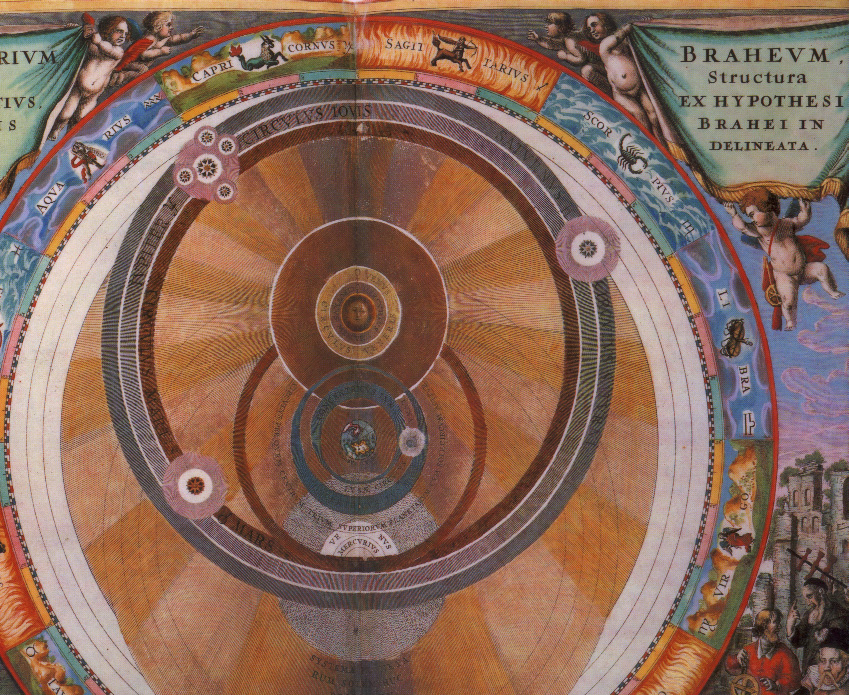The Copernican Revolution. Moving man and the earth off center stage, the center of the universe. Finally published on the deathbed…
…The departure of Georg Joachim Rheticus, though his name was never mentioned by his teacher seems to have decided Copernicus, now an old man by the standards of the age, that the time had come to cease his labors and let his manuscript be made available for all to read. He gave it to Bishop Giese, who promptly sent it to Rheticus for publication under the title De revolutionibus orbium coelestium. Rheticus gave it for printing to a friend in Nuremberg interested in astronomy and asked Andreas Osiander to see it through the press. Eminent churchmen and devout Lutheran that he was, Osiander introduced an extra unsigned preface in which he warned those who may have heard of the author’s work not to be alarmed, since the motions of the earth there described are hypothetical only.

—Tycho Brahe’s cosmic portrayal of the terra/solar system as a sort of ‘compromise’ between the Heliocentric & geocentric schools of astronomy.—Read More:http://myweb.rollins.edu/jsiry/What_Science_Is.html
Copernicus never knew of this preface; for at least six months before his death on May 24, 1543, he was partially paralyzed and bedridden, and although he saw a copy of the finished book, it is unlikely that he was fully aware of it.
If he had been , he is not likely to have agreed with Osiander. He may have been cautious, and slow to venture into print because of “the scorn which I had to fear on account of the novelty and incongruity of my theory”- scorn that might come from the unlearned, and indeed had come from Luther and others as a result of his letting the Commentariolus circulate widely; yet his friends; far from hissing him off the stage, had encouraged him on every hand.
Finally, reflecting that “mathematics are for mathematicians,” who would understand, and that the work would be useful for the church’s calendar reform, he had decided to let the long-matured book appear. All this Copernicus confided in his own preface to De revolutionibus, which was addressed to Pope Paul III and therefore written after 1534. ( to be continued)…
![---Luther saw that Copernicus's view was indeed a revolutionary one. He could not accept it because it was contrary to his common sense and his interpretation of the Bible. That a person in a cart moving at constant velocity is at rest with respect to the cart, while trees are in motion with respect to him, is an example of what is now called Galilean relativity. By quoting Joshua [23] Luther, of course, did not refute Copernicus [24]. Johannes Kepler later applied Luther's own principle of biblical interpretation to the passage by saying that it only appeared that the sun stood still, but it would actually have been the earth [25]. ---Read More:http://www.leaderu.com/science/kobe.html](/wp-content/uploads/2012/12/copernicus3.jpg)
—Luther saw that Copernicus’s view was indeed a revolutionary one. He could not accept it because it was contrary to his common sense and his interpretation of the Bible. That a person in a cart moving at constant velocity is at rest with respect to the cart, while trees are in motion with respect to him, is an example of what is now called Galilean relativity. By quoting Joshua [23] Luther, of course, did not refute Copernicus [24]. Johannes Kepler later applied Luther’s own principle of biblical interpretation to the passage by saying that it only appeared that the sun stood still, but it would actually have been the earth [25]. —Read More:http://www.leaderu.com/science/kobe.html
(see link at end)…hen the news of Copernicus’ promotion of the belief that the earth orbits the sun reached the ears of the Reformers, they
expressed their disapproval of the idea. Most notable of those was Martin Luther who expressed some anxiety about possible consequences
of the theory if it should ever be accepted as true. Throughout the history of the debate between geocentricity and heliocentrism, Christian and Jewish theologians expressed a moral uneasiness about the decentralization of the earth.
After less than a couple of decades of heliocentrism, the heliocentrists started to argue that since no moral upset seemed in the offing, that the Biblicists must be wrong in their voicing of moral reservations against heliocentrism. But in that they were premature. Heliocentrism did not become the dominant opinion until about 1650, one hundred years after the publication of Copernicus’ book which triggered the shift from geocentrism. Furthermore, history shows that it takes at least a generation for the long-term effects of a change in morality to manifest themselves. Changes in mores do not have immediate full impact on populations. Thus, to gauge the effect of heliocentrism we must look beyond the first generation which completely adopts it….Read More:http://www.geocentricity.com/geocentricity/primer.pdf





 COMMENTS
COMMENTS